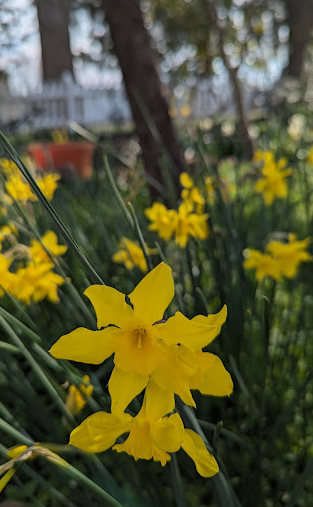Roman Hyacinths
- Clifford Brock
- Feb 7, 2021
- 3 min read
According to Greek myth, the flower hyacinth arose from the blood of the beautiful youth Hyacinth after he was tragically killed by the jealous god Zephyrus. In some accounts, this loss so saddened the god Apollo that he turned the boy into the purple hyacinth, a color strongly associated with the cult of Apollo.
The Meditaranin region of Europe and North Africa is home to so many of our iconic bulbs. It is there that we find wild daffodils, crocus, tulips, and hyacinths. Hyacinths are in the diverse lily family but are most closely related to grape hyacinths and Spanish bluebells.
Most of us are familiar with the cartoonish and colorful Dutch hyacinths so often seen in grocery stores around this time of year. These man-made hybrids are fragrant and look great in our houses, but I find them difficult to integrate into naturalistic landscapes. They also prefer consistently colder winters than we typically get here in middle Georgia.

But there is a cool heirloom often seen around old houses in the south that is the wild ancestor of those gaudy hybrids. It looks different, more like a bluebell, yet it retains the intoxicating fragrance of its descendants. It is also notable in that it multiplies freely and doesn't require as much chilling. Overall Roman hyacinths, or Hyacinthus orientalis ssp. albulus are wonderful additions to the southern landscape. But they remain hard to find in the trade!
The bulbs are best purchased and planted in the fall. They are easy to grow, although I've found them a little difficult to divide and transplant because the bulbs are so deep. Unlike members of the amaryllis family, like spider lilies and daffodils, hyacinths seem to prefer to be around 4 in. deep at a minimum. And though they are poisonous to humans, they can be tempting snacks to rodents and deer, so protect them especially after planting. A generous sprinkling of cinnamon or black pepper works for me.
When my folks bought their old house back in 2001, there were many snowflakes, narcissus, and spider lilies, but there were very few wild hyacinths. But over the years I've divided the few original clumps and moved them around, btw this can be done anytime. Now I've got around 10 decent-sized specimens, and I've augmented my collection by adding the more compact cultivar 'Anastacia'- which resembles the Roman type. You can find this cultivar at https://brentandbeckysbulbs.com. 'Anastacia' seems to bloom a few weeks earlier than the wild Roman types, but it is reliable and very fragrant!

Like many ephemeral bulbs, hyacinths bloom shade or sun, though it has to be deciduous shade, trees that lose their leaves in winter.
There seem to be 3 primary color variations: white, purple, and pink. It is really difficult to find these for sale, but I have seen them at Old House Gardens. Your best bet is to 1) purchase an old southern house with lots of heirloom bulbs or 2) befriend someone who has them. Unfortunately, they can be quite expensive, but if you are crazy like me and are addicted to plants, you can purchase the 3 color forms here: (https://oldhousegardens.com/display/category/Hyacinth#!)

Hope you can grow these treasures. You will be rewarded with decades of color and sweet perfume.
Our yards should be repositories of heirloom plants like this so make an effort to learn more and foster a love for hardy bulbs and perennials.




Comments